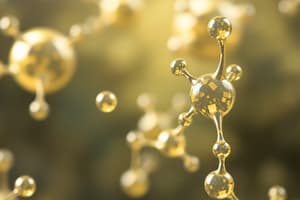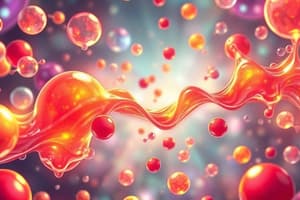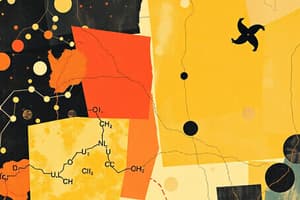Podcast
Questions and Answers
What is the systematic name for linoleic acid?
What is the systematic name for linoleic acid?
Cis, cis, 9, 12-Octadecadienoic acid
How many double bonds are present in arachidonic acid?
How many double bonds are present in arachidonic acid?
Four double bonds
What type of fatty acid is linolenic acid and how many double bonds does it have?
What type of fatty acid is linolenic acid and how many double bonds does it have?
Linolenic acid is a polyunsaturated fatty acid with three double bonds.
What structural characteristic distinguishes the cis form of these fatty acids?
What structural characteristic distinguishes the cis form of these fatty acids?
Which fatty acid is considered a precursor to eicosanoids?
Which fatty acid is considered a precursor to eicosanoids?
What is the primary difference between oils and fats in terms of physical state?
What is the primary difference between oils and fats in terms of physical state?
Name the three primary groups of lipids and provide a brief description of each.
Name the three primary groups of lipids and provide a brief description of each.
What are triglycerides primarily composed of, and what is their significance in biological systems?
What are triglycerides primarily composed of, and what is their significance in biological systems?
Identify two examples of oils and two examples of fats.
Identify two examples of oils and two examples of fats.
Explain the role of sterols in the body.
Explain the role of sterols in the body.
What is the significance of crystallization in food processing?
What is the significance of crystallization in food processing?
How does the visual appearance of chocolate relate to its crystallization process?
How does the visual appearance of chocolate relate to its crystallization process?
What role do minority lipids, like DAGs and MAGs, play in food products?
What role do minority lipids, like DAGs and MAGs, play in food products?
What is the impact of oil exudation during the processing of cooking oils?
What is the impact of oil exudation during the processing of cooking oils?
Explain how emulsification is important in products like butter and mayonnaise.
Explain how emulsification is important in products like butter and mayonnaise.
Why are long-chain fatty acids practically insoluble in water?
Why are long-chain fatty acids practically insoluble in water?
How does the solubility of fatty acids vary with carbon chain length?
How does the solubility of fatty acids vary with carbon chain length?
What causes the solid character of fats?
What causes the solid character of fats?
What is the significance of crystal size in fats?
What is the significance of crystal size in fats?
What role do Van der Waals forces play in fat crystallization?
What role do Van der Waals forces play in fat crystallization?
Why is slow cooling important in fat crystallization?
Why is slow cooling important in fat crystallization?
How do solid-liquid phase transitions affect food processing?
How do solid-liquid phase transitions affect food processing?
What impacts do crystallization behaviors have on food products?
What impacts do crystallization behaviors have on food products?
What is the role of emulsifiers in food products like mayonnaise and salad dressings?
What is the role of emulsifiers in food products like mayonnaise and salad dressings?
Name two types of emulsifiers that can be used to stabilize emulsions.
Name two types of emulsifiers that can be used to stabilize emulsions.
What natural emulsifier is found in egg yolk, and what is its significance in food formulations?
What natural emulsifier is found in egg yolk, and what is its significance in food formulations?
How much oil can the lecithin from one egg yolk emulsify?
How much oil can the lecithin from one egg yolk emulsify?
What are some food products that utilize phospholipids for emulsification?
What are some food products that utilize phospholipids for emulsification?
How do emulsifiers like lecithin affect chocolate formulations?
How do emulsifiers like lecithin affect chocolate formulations?
What is the relationship between fat and aqueous matrices in meat emulsions?
What is the relationship between fat and aqueous matrices in meat emulsions?
Why is it important to stabilize emulsions in food formulations?
Why is it important to stabilize emulsions in food formulations?
Why should emulsifying agents be mixed with the continuous phase before adding the dispersed phase?
Why should emulsifying agents be mixed with the continuous phase before adding the dispersed phase?
What role does cholesterol play in emulsification?
What role does cholesterol play in emulsification?
How does mustard function as an emulsifier compared to lecithin?
How does mustard function as an emulsifier compared to lecithin?
In what way can mayonnaise support the emulsification of other food products?
In what way can mayonnaise support the emulsification of other food products?
What is a unique characteristic of honey as an emulsifier?
What is a unique characteristic of honey as an emulsifier?
Describe the physical process needed when preparing an emulsion.
Describe the physical process needed when preparing an emulsion.
What distinguishes a permanent emulsion from a semi-permanent emulsion?
What distinguishes a permanent emulsion from a semi-permanent emulsion?
What are the two distinct sections of a semi-permanent emulsion like hollandaise sauce?
What are the two distinct sections of a semi-permanent emulsion like hollandaise sauce?
Flashcards
Fat
Fat
A type of lipid found in food that is a solid at room temperature.
Oil
Oil
A type of lipid found in food that is a liquid at room temperature.
Triglyceride
Triglyceride
A type of lipid made of three fatty acid chains attached to a glycerol molecule.
Phospholipid
Phospholipid
Signup and view all the flashcards
Sterol
Sterol
Signup and view all the flashcards
Linoleic acid
Linoleic acid
Signup and view all the flashcards
Linolenic acid
Linolenic acid
Signup and view all the flashcards
Arachidonic acid
Arachidonic acid
Signup and view all the flashcards
Omega-3 fatty acid (ω-3 fatty acid)
Omega-3 fatty acid (ω-3 fatty acid)
Signup and view all the flashcards
Omega-6 fatty acid (ω-6 fatty acid)
Omega-6 fatty acid (ω-6 fatty acid)
Signup and view all the flashcards
Solubility of Fatty Acids
Solubility of Fatty Acids
Signup and view all the flashcards
Solubility and Carbon Chain Length
Solubility and Carbon Chain Length
Signup and view all the flashcards
Solid State of Lipids
Solid State of Lipids
Signup and view all the flashcards
Crystal Size and Texture
Crystal Size and Texture
Signup and view all the flashcards
Van der Waals Forces in Fats
Van der Waals Forces in Fats
Signup and view all the flashcards
Slow Cooling and Crystal Formation
Slow Cooling and Crystal Formation
Signup and view all the flashcards
Crystallization and Food Properties
Crystallization and Food Properties
Signup and view all the flashcards
Crystallization in Food Processing
Crystallization in Food Processing
Signup and view all the flashcards
Crystallization of Fats
Crystallization of Fats
Signup and view all the flashcards
Fat Migration
Fat Migration
Signup and view all the flashcards
Emulsions
Emulsions
Signup and view all the flashcards
Crystal Form Impact
Crystal Form Impact
Signup and view all the flashcards
Lipids in Food Quality
Lipids in Food Quality
Signup and view all the flashcards
Emulsifier
Emulsifier
Signup and view all the flashcards
Types of emulsifiers
Types of emulsifiers
Signup and view all the flashcards
Meat Emulsion
Meat Emulsion
Signup and view all the flashcards
Lecithin
Lecithin
Signup and view all the flashcards
Lecithin's role in emulsions
Lecithin's role in emulsions
Signup and view all the flashcards
Lecithin in Chocolate
Lecithin in Chocolate
Signup and view all the flashcards
Importance of Emulsions in Food
Importance of Emulsions in Food
Signup and view all the flashcards
Oil-in-water emulsion
Oil-in-water emulsion
Signup and view all the flashcards
Water-in-oil emulsion
Water-in-oil emulsion
Signup and view all the flashcards
Amphiphilic emulsifier
Amphiphilic emulsifier
Signup and view all the flashcards
Dispersed phase
Dispersed phase
Signup and view all the flashcards
Continuous phase
Continuous phase
Signup and view all the flashcards
Emulsification
Emulsification
Signup and view all the flashcards
Study Notes
LIPIDS I
- The presentation covers lipids, including types, structure, and physical properties found in food.
- Learning outcomes include understanding lipid types, structures, and physical properties in food.
- Lipids include substances like fats, oils, and waxes found in various food products. Images of food containing lipids are shown.
- Oils (liquid) and fats (solid) are examples of lipids. Different types of oils and fats are listed.
- The presentation shows a table of fat content in various foods. Specific examples like walnuts, milk, butter, chicken, and cod are included with their respective fat percentages.
- Examples of three primary lipid groups are triglycerides, phospholipids, and sterols. These are discussed in terms of their roles in food and/or cell membranes.
- Triglycerides (triacylglycerols) are mainly composed of fatty acids esterified to glycerol. They are the major component of animal and plant fats and are essential components in cell membranes
- Phospholipids are modified triglycerides, including lecithin, a key emulsifier in food.
- Sterols are non-polar, and examples include cholesterol, a precursor for bile acids and vitamin D.
- Waxes include wax esters, sterol esters, ketones, aldehydes, alcohols, and sterols. Beeswax is an example of a wax. Waxes are often used as food wraps or fruit coatings.
- Triglyceride abbreviations are explained using the first letter of the common names (e.g., StStSt for tri-stearin).
- Glyceride compositions are described in terms of saturated (S) and unsaturated (U) fatty acids. Examples include the abbreviation SSS and SUS for glyceride types.
- The presentation also describes how triglycerides are formed from glycerol and fatty acids (chemical reactions).
- Different types of fatty acids are classified as saturated (SFA), monounsaturated (MUFA), and polyunsaturated (PUFA). The presentation also distinguishes them by carbon chain length (e.g., short chain, medium chain, long chain)
- The structure of a fatty acid is described as having a methyl group at one end and a carboxyl group at the other.
- The concept of degree of saturation and examples are given for saturated (e.g., palmitic, stearic), monounsaturated (e.g., oleic), and polyunsaturated (e.g., linoleic, linolenic) fatty acids.
- The presentation explains cis and trans configurations of unsaturated fatty acids. The cis form has hydrogen atoms on the same side of the double bond, while the trans form has them on opposite sides.
- Fat composition of higher animals, ruminant milk lipids, and fruit coat fats are covered.
- Marine and algal oils are classified as being low in saturated fat and high in unsaturated fatty acids; examples include EPA and DHA.
- The physical properties of lipids, including chemical composition, melting points, and crystalline structure, are discussed.
- Factors like chain length and configuration (cis/trans) affect melting points.
- The solubility of fatty acids depends on carbon chain length. Short-chain fatty acids are more soluble in water than long-chain fatty acids.
- Lipids can exist in solid and liquid forms. Crystal size and lattice structure impact the physical characteristics of the fat/lipid e.g. chocolate, biscuits, and cakes.
- Crystallization of fats in food products: The importance of crystallization in food applications is detailed.
- Polymorphic behavior in commercial fat is explained, along with examples of fats that crystallize in the β' and β forms.
- The formation of different crystal forms (polymorphs) in various fats like cocoa butter due to the cooling process. This process is essential for the quality of food products like chocolate.
- Types of Emulsions are described, including oil-in-water (o/w) and water-in-oil (w/o) and their importance.
- Natural emulsifiers are presented with examples like lecithin, phospholipids, cholesterol, and their uses.
- Methods of preparing emulsions are given, with the need for physical action (e.g., beating, stirring) to promote dispersion.
- The factors that affect emulsion stability are listed, including viscosity, emulsifier concentration, droplet size, and the ratio of dispersed phase to continuous phase.
Studying That Suits You
Use AI to generate personalized quizzes and flashcards to suit your learning preferences.




